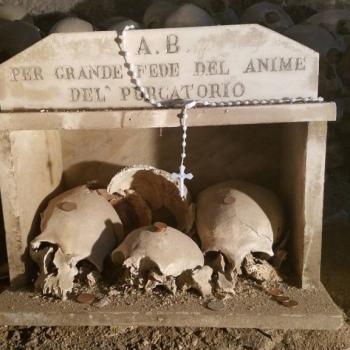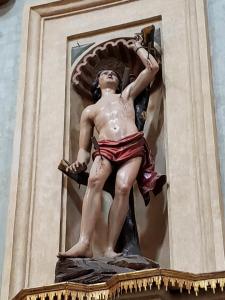
Having contemplated hundreds of Catholic saints over the past decade for my research both on Santa Muerte and Catholic death culture, I am intrigued by one in particular whom I have seen in countless churches across Europe and Latin America. Saint Sebastian was a third-century Roman martyr who during the the intense Diocletianic Persecution of Christians was ordered to face a firing squad of archers for his monotheistic faith. Though shot full of arrows, Sebastian, a Roman solider, miraculously survived, according to his hagiography. Saint Irene went to collect his body for Christian burial and discovered Sebastian still clinging to life and nursed him back to health over the course of several days. Undaunted by his near death, the brave soldier went to confront the pagan emperor Diocletian publicly on his pogrom against Christians. This time Sebastian didn’t survive the execution by clubbing that Diocletian ordered for his brazen defiance of imperial rule. Saint Lucy recovered his body from a Roman sewer where it had been dumped and had Sebastian buried in a Roman catacomb where a basilica dedicated to the martyred saint was eventually erected.
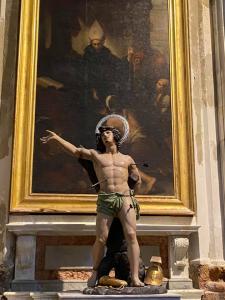
Beside being one of the saints I have seen most often at scores of churches and shrines across Latin America and Europe, the scantily clad and muscular saint interests me due to his relevance to my research on Catholic death culture and faith healing. The Roman saint is associated with both the concept of Holy Death (one of Santa Muerte’s English translations) and the Black Plague. Medieval Europeans correlated the apparent randomness with which the Plague struck to an indiscriminate rain of arrows from the sky. And since Sebastian was already associated with arrows, he, along with French saint, Roch, became one of the most popular guardian saints during the Black Death. Of course, it was also at this same time that the figure of the Grim Reaper first emerged in European art as a skeletal personification of death. Since the Reaper and Reapress (in Mediterranean countries) were harvesting European souls at unprecedented rates during the Plague, countless Christians turned to the martyred Sebastian for both protection from the insidious pandemic and for a good Catholic death in the event that the random arrows of the Black Death pierced the saint’s protective shield.
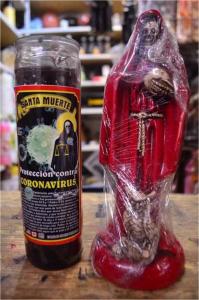
The Roman holy man’s role as both supernatural protector from the Plague and patron of Holy Death find extraordinary historical continuity in Mexican folk saint Santa Muerte’s present role as protectress and healer, not to mention granting a Good Death, for Mexican devotees battling Coronavirus in one of the hardest hit countries on the planet. That one of the English translations of her name is Holy Death (Saint Death is the other) captures the paramount importance of the Skeleton Saint’s mission of attending to those who seek a relatively peaceful and painless demise. And the contemporary parallels between Sebastian and Santa Muerte have an intriguing historical precedent.
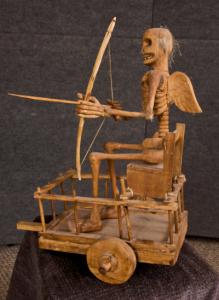
Doña Sebastiana was a female personifcation of death, typically marked by snow-white hair, whose wooden effigy was pulled in a death cart during Holy Week processions by Penitentes in 19th-century New Mexico and Colorado. While Sebastian’s body was riddled with arrows from the firing squad, Doña Sebastiana was most often depicted pulling a bow and arrow for reaping the soul of an unsuspecting mortal. That there is no Catholic saint named Sebastiana is further evidence that the Catholic brotherhoods of isolated mountain towns in the southern Rockies who practiced a heterodox Mexican folk Catholicism associated Sebastian, the Plague saint and patron of Good Death, with la Parca, the Spanish Grim Reapress, and in a fascinating case of New World religious syncretism fused the two to create Doña Sebastiana, whom the Penitentes also referred to as Santa Muerte in their hymns and prayers.
Remarkably, the syncretism and parallels between the Roman martyr and Mexican death saint aren’t limited to protection, healing, and mortality but even extend to the realm of sexual orientation. Because of the abundant homoerotic depictions of Sebastian as a scantily clad Adonis, the patron saint also of soldiers has become a gay icon embraced by many queer men as a symbol of heroic resistance to societal oppression and discrimination. In a similar vein, Santa Muerte is the unofficial matron saint of hundreds of thousands of LGBTQ folks in Mexico and the US and beyond because she is death and death accepts all comers, no matter sexual orientation, occupation or nationality. Such is her appeal to North American LGBTQ communities that her rainbow colored votive candle, known as Santa Muerte of the 7 Powers, appears to be morphing into LGBTQ Skeleton Saint, especially since many recent devotees aren’t familiar with the color symbolism of the fastest growing new religious movement in the West.
In short, that Saint Sebastian has remained relevant across the centuries gives testament to the paramount importance of the interrelated themes of faith healing and a good death in societies of Christian heritage. It is no coincidence that the NRM of Santa Muerte has experienced meteoric growth in large measured based on the folk saint’s reputation for healing the sick and granting a good death to Mexicans plagued by so much bad death.




